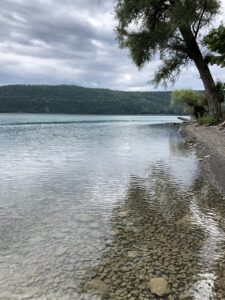Lake Update
Biological Field Station update
on algae bloom in Otsego lake

The Biological Field Station (BFS) collected samples for toxin analysis around Otsego Lake yesterday, 22 August 2022. All sites had detectable levels of the toxin microcystin, though concentrations lake-wide were generally less than last week. Results for each location are below. We provide these results for informational purposes and to aid in decision-making; these results represent a snapshot in time. Bloom conditions are known to change rapidly with weather. When there are visible accumulations on the shoreline or the water surface, caution is warranted. A link to DOH guidance is below. The cyanobacteria causing the bloom is called Microcystis aeruginosa.
Sample Collection Notes: Collection began at 10:00am at Three Mile Point; we proceeded clockwise around the lake. Weather conditions: overcast, occasional light rain, Air temp 70° F. No surface accumulations were visible where samples were collected. Small accumulations were observed in protected areas around boats and docks at both BFS properties.
You have reached your limit of 3 free articles
To Continue Reading
Our hard-copy and online publications cover the news of Otsego County by putting the community back into the newspaper. We are funded entirely by advertising and subscriptions. With your support, we continue to offer local, independent reporting that is not influenced by commercial or political ties.

